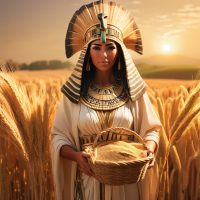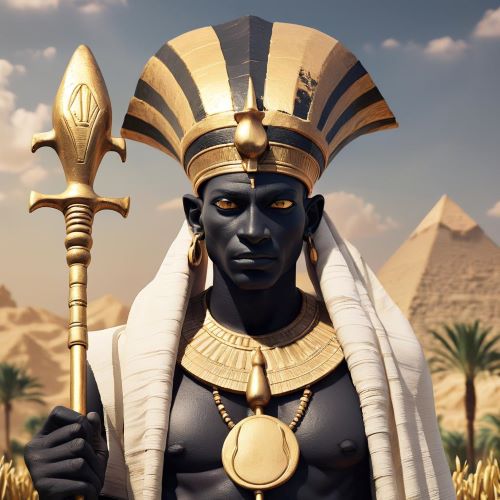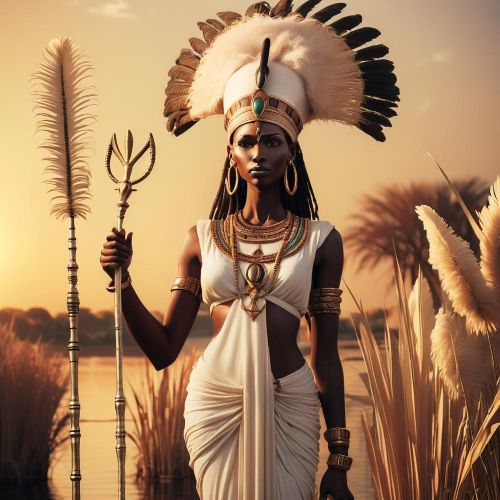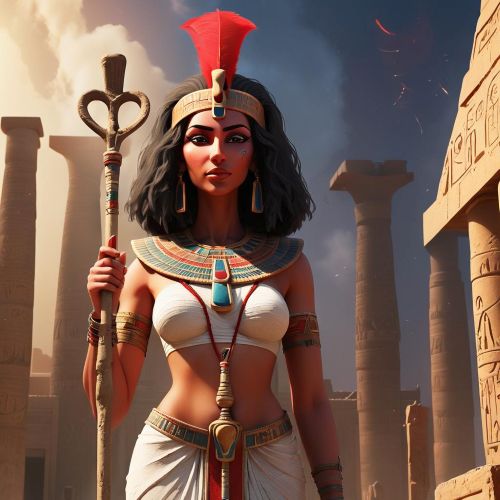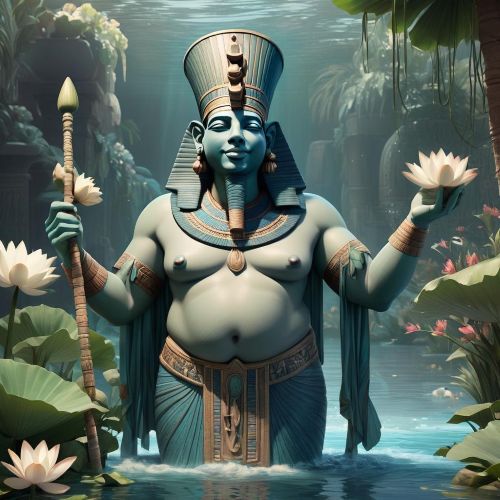Nepit : Goddess of Grain
Listen
At a glance
| Description | |
|---|---|
| Origin | Egyptian Mythology |
| Classification | Gods |
| Family Members | Neper (Husband) |
| Region | Egypt |
| Associated With | Food, Fertility |
Nepit
Introduction
Nepit, the Egyptian goddess of grain, embodies the essence of nourishment, fertility, and the eternal cycle of life sustained by the Nile. Although lesser-known compared to figures like Isis or Hathor, her significance is deeply rooted in the agricultural heartbeat of ancient Egypt. Her name itself, derived from the Egyptian term for “grain,” reflects her sacred association with sustenance and abundance. Nepit represented the physical and spiritual nourishment that allowed civilization to thrive along the fertile banks of the Nile. Revered as the divine provider of food and fertility, she personified the transformation of earth’s bounty into the lifeblood of human existence.
Physical Traits
Artistic depictions of Nepit are modest yet profoundly symbolic. She is often portrayed as a serene woman adorned with sheaves of wheat or barley, sometimes crowned with a headdress shaped like a bundle of grain. Her imagery emphasizes the nurturing power of the land—her skin may be rendered in dark hues, representing the rich, fertile soil of the Nile Valley. In some reliefs, she holds a stalk of grain or a vessel of harvested wheat, signifying her guardianship over food supplies and the agricultural cycle. Her appearance exudes calmness and maternal warmth, contrasting with the grandeur or ferocity of other deities. Nepit’s visual language—grain, soil tones, and simple attire—reflects her intimate connection to daily life and the people’s reliance on the harvest.
Family
Nepit’s mythology places her within a divine triad representing the agricultural process from growth to harvest. She is typically described as the female counterpart of Neper (also called Nepri or Nepra), the god of grain. Their union symbolizes the fertile balance between male and female forces necessary for growth and regeneration. Renenutet, the goddess of nourishment and harvest, is often cited as Neper’s mother, making her a maternal figure in Nepit’s mythic circle as well. This triad—Renenutet, Neper, and Nepit—represents the complete life cycle of food: from nurturing and growth to reaping and renewal. Nepit also shares symbolic connections with Osiris, the god of vegetation and resurrection, whose myths of death and rebirth mirror the agricultural cycles she governs. Through these relationships, Nepit is intricately woven into the fabric of Egyptian cosmology, emphasizing fertility as both a divine and earthly force.
Other names
Like many deities in Egyptian religion, Nepit was known by several names that reflected linguistic variations and regional traditions. In inscriptions and temple texts, she may appear as Nepyt, Nepra, or Nebyt. Each variant captures nuances of her identity while retaining her core association with grain and sustenance. The fluidity of her name mirrors the way her worship spread across different regions and dynasties, adapting to local dialects and evolving agricultural customs. In some records, her name is closely linked to that of Neper, her male counterpart, leading to overlapping depictions where both are invoked together as embodiments of abundance. The recurring translation of her name as “Lady of Grain” or “Mistress of the Harvest” reinforces her enduring role as a provider and protector of life’s essentials.
Powers and Abilities
Nepit’s powers are intrinsically connected to the fertility of the earth and the prosperity of the people. As the goddess of grain, she was believed to ensure bountiful harvests, protect crops from disease and pests, and maintain the delicate balance of the Nile’s flooding cycles that sustained Egyptian agriculture. Her blessings were sought by farmers during planting and harvesting seasons, as well as by households seeking nourishment and stability. Offerings to Nepit often included loaves of bread, beer, and newly gathered grain—symbols of both gratitude and hope for future abundance. Beyond agriculture, her influence extended into spiritual realms: grain, the foundation of life, also represented resurrection and continuity in Egyptian funerary practices. Just as crops died and returned anew each season, Nepit symbolized the eternal cycle of life, death, and rebirth. Through her, the Egyptians expressed their understanding that survival depended not only on physical sustenance but also on maintaining harmony with nature’s rhythms.
Nepit’s presence was both protective and maternal. She watched over stored grain, shielding it from decay and theft, and guarded the spiritual wellbeing of those who labored on the land. Her powers were invoked in prayers for prosperity, security, and renewal, making her an integral part of Egypt’s spiritual connection to the soil. While she did not wield cosmic authority like Ra or Isis, Nepit’s strength was grounded in the everyday miracle of growth—the quiet yet constant assurance of life sustained through the earth’s bounty.
Modern Day Influence
Although direct worship of Nepit faded with the decline of ancient Egyptian religion, her influence endures in subtle and meaningful ways. The reverence for grain as the foundation of life continues to resonate in modern Egyptian culture, particularly in rural communities that still mark agricultural cycles with seasonal festivals. Many of these traditions, though now secular or Islamic in form, echo the ancient gratitude once directed toward deities like Nepit. Her archetype as a nurturing provider also persists in global symbols of harvest goddesses, influencing depictions of fertility and abundance in art and literature.
In academic and cultural contexts, Nepit has gained renewed attention through Egyptological research and museum exhibitions focusing on lesser-known deities. Scholars studying the interdependence of religion and agriculture frequently cite Nepit as a prime example of localized divinity—one whose worship embodied the environmental realities of Nile-based life. Contemporary spiritual movements, particularly those within neo-pagan and Kemetic revivalist traditions, have begun to reintroduce Nepit into rituals celebrating fertility, sustainability, and ecological balance. Her association with grain, nourishment, and renewal aligns naturally with modern concerns about food security and environmental stewardship.
Artists and writers inspired by ancient mythologies often evoke Nepit as a symbol of resilience and nurturing strength. In visual art, she is reimagined as a figure of grounded abundance, her grain headdress and earthy tones representing the interconnectedness of human sustenance and the natural world. In literature, Nepit serves as a metaphor for renewal—whether in the cycles of nature or in the resilience of communities rebuilding after hardship.
Ultimately, Nepit’s legacy is one of continuity. She stands as a reminder that the simplest elements—soil, seed, water, and care—form the foundation of civilization. Though her temples may have fallen silent, the reverence she inspired still lives in every harvest, every loaf of bread, and every ritual act of gratitude toward the earth’s enduring fertility.
Related Images
Source
Godchecker. (2023). Nepit: Goddess of Corn/Maize. Retrieved from https://www.godchecker.com/egyptian-mythology/NEPIT/
Wikipedia. (2004). Neper (mythology). Retrieved from https://en.wikipedia.org/wiki/Neper_(mythology)[10]
World Mythos. (n.d.). Nepit. Retrieved from https://worldmythos.com/nepit/
Kiddle Encyclopedia. (2021, December 31). Neper (mythology) Facts for Kids. Retrieved from https://kids.kiddle.co/Neper_(mythology)[6]
Cairo Top Tours. (2023, January 21). Neper God Of Grain. Retrieved from https://www.cairotoptours.com/en-au/egypt-travel-guide/gods-of-ancient-egypt/neper-god-of-grain
Wilkinson, R. H. (2003). The Complete Gods and Goddesses of Ancient Egypt. Thames & Hudson.
Pinch, G. (2002). Handbook of Egyptian Mythology. ABC-CLIO.
Hart, G. (2005). The Routledge Dictionary of Egyptian Gods and Goddesses. Routledge.
Lesko, B. S. (1999). The Great Goddesses of Egypt. University of Oklahoma Press.
Assmann, J. (2001). The Search for God in Ancient Egypt. Cornell University Press.
Frequently Asked Questions
What is lorem Ipsum?
I am text block. Click edit button to change this text. Lorem ipsum dolor sit amet, consectetur adipiscing elit. Ut elit tellus, luctus nec ullamcorper mattis, pulvinar dapibus leo.
What is lorem Ipsum?
I am text block. Click edit button to change this text. Lorem ipsum dolor sit amet, consectetur adipiscing elit. Ut elit tellus, luctus nec ullamcorper mattis, pulvinar dapibus leo.
What is lorem Ipsum?
I am text block. Click edit button to change this text. Lorem ipsum dolor sit amet, consectetur adipiscing elit. Ut elit tellus, luctus nec ullamcorper mattis, pulvinar dapibus leo.
What is lorem Ipsum?
I am text block. Click edit button to change this text. Lorem ipsum dolor sit amet, consectetur adipiscing elit. Ut elit tellus, luctus nec ullamcorper mattis, pulvinar dapibus leo.
What is lorem Ipsum?
I am text block. Click edit button to change this text. Lorem ipsum dolor sit amet, consectetur adipiscing elit. Ut elit tellus, luctus nec ullamcorper mattis, pulvinar dapibus leo.


